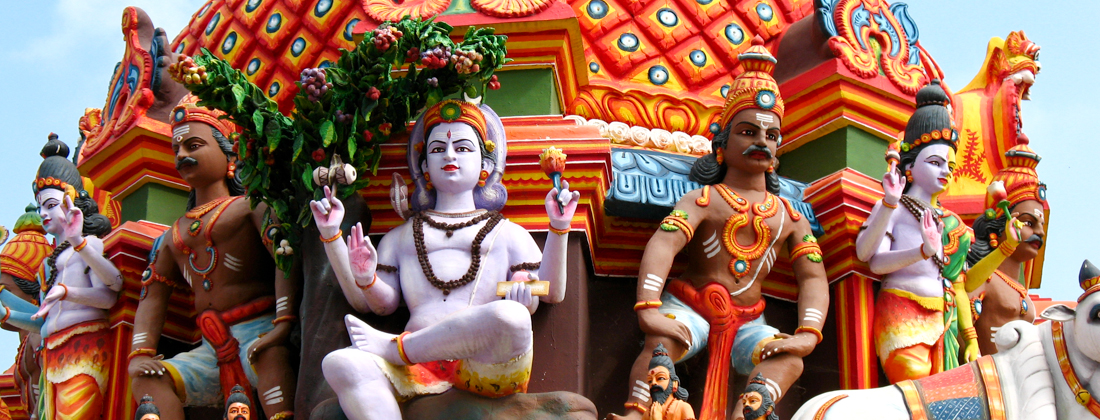
Tamil Nadu – Places to Visit
Auroville
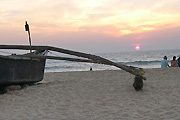 The Integral Yoga of Sri Aurobindo forms the underlying spiritual foundation of Auroville, an international township in the making, founded in 1968. About 2400 members from over 45 nations reside there. The aim of the community is the realization of human unity through the process of a collaborative effort to build the city. The spiritual center is the Matrimandir, a spherical building with a rather extraordinary meditation room. The Visitor’s Information Centre offers exhibitions and video tutorials, giving visitors a comprehensive overview of the ideal and the activities of Auroville. On request, a free pass is issued for a visit to the “Viewing Terrace” in the Matrimandir garden.
The Integral Yoga of Sri Aurobindo forms the underlying spiritual foundation of Auroville, an international township in the making, founded in 1968. About 2400 members from over 45 nations reside there. The aim of the community is the realization of human unity through the process of a collaborative effort to build the city. The spiritual center is the Matrimandir, a spherical building with a rather extraordinary meditation room. The Visitor’s Information Centre offers exhibitions and video tutorials, giving visitors a comprehensive overview of the ideal and the activities of Auroville. On request, a free pass is issued for a visit to the “Viewing Terrace” in the Matrimandir garden.
Chennai (Madras)
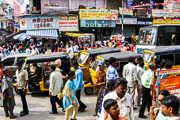 Situated on the east coast, this sprawling capital of Tamil Nadu is an ideal arrival and departure point for tours in Southeast India because of its excellent air and rail links. The Government Museum in Egmore district, founded in 1857, provides an interesting insight into the cultural history of the land with its collection of exquisite exhibits. Built in 1644 and being the first British fort in India, Fort St. George was an important base for the British East India Company and is now the seat of the Tamil Nadu state government. St. Thomas Mount, in the vicinity of the airport, is a famous pilgrimage site for the Saint Thomas Christians, whose history traces back to the first mission of the Apostle Thomas. A church, built in 1523, is situated on top of the hill, its altar marking the spot where, according to tradition, St. Thomas died as a martyr in 72 AD. In Adiyar district one can find the world headquarters of the Theosophical Society and the famous Kalakshetra dance and music school. Stretching for several kilometers, Marina Beach is a popular destination for an evening stroll on the beach.
Situated on the east coast, this sprawling capital of Tamil Nadu is an ideal arrival and departure point for tours in Southeast India because of its excellent air and rail links. The Government Museum in Egmore district, founded in 1857, provides an interesting insight into the cultural history of the land with its collection of exquisite exhibits. Built in 1644 and being the first British fort in India, Fort St. George was an important base for the British East India Company and is now the seat of the Tamil Nadu state government. St. Thomas Mount, in the vicinity of the airport, is a famous pilgrimage site for the Saint Thomas Christians, whose history traces back to the first mission of the Apostle Thomas. A church, built in 1523, is situated on top of the hill, its altar marking the spot where, according to tradition, St. Thomas died as a martyr in 72 AD. In Adiyar district one can find the world headquarters of the Theosophical Society and the famous Kalakshetra dance and music school. Stretching for several kilometers, Marina Beach is a popular destination for an evening stroll on the beach.
Chidambaram
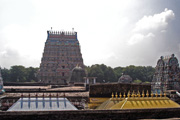 Surrounded by four imposing temple towers, the Nataraja temple in Chidambaram is one of the holiest places in South India. Numerous ceremonies and a traditional atmosphere offer fascinating insight into the ritualized world of Hinduism. Shiva is worshiped here in the form of Nataraja who expresses five forces through his cosmic dance: creation, preservation, destruction, illusion and grace. The construction of the 600 x 495 m large temple complex was started in the 10th century by the Chola dynasty. Characteristic of the Dravidian style is a rectangular floor plan and a firm geometric structure. The 40 m high gopurams (gateway towers) form the entrance gateways to the courtyard, which contains the central sanctum, the temple pond and several secondary shrines. The western and eastern gateways are decorated with the entire 108 basic positions of South Indian Bharatanatyam dance.
Surrounded by four imposing temple towers, the Nataraja temple in Chidambaram is one of the holiest places in South India. Numerous ceremonies and a traditional atmosphere offer fascinating insight into the ritualized world of Hinduism. Shiva is worshiped here in the form of Nataraja who expresses five forces through his cosmic dance: creation, preservation, destruction, illusion and grace. The construction of the 600 x 495 m large temple complex was started in the 10th century by the Chola dynasty. Characteristic of the Dravidian style is a rectangular floor plan and a firm geometric structure. The 40 m high gopurams (gateway towers) form the entrance gateways to the courtyard, which contains the central sanctum, the temple pond and several secondary shrines. The western and eastern gateways are decorated with the entire 108 basic positions of South Indian Bharatanatyam dance.
Darasuram
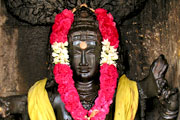 Built in the late period of the Chola dynasty in the mid-12th century, the Airavatesvara temple in Darasuram is considered an exquisite gem of Dravidian temple architecture. In recent years, it has been carefully restored and embedded in a well-maintained complex. With its designation as a UNESCO world heritage site in 2004, it is recognized today as one of the most important monuments of Chola architecture. A special attraction is the south-facing stair entrance shaped in the form of a chariot which connects to an open colonnade which turns into a spacious main hall with decorative pillars and ceiling decorations. Noteworthy are the many niche sculptures and the rich sculptural decorations on columns and friezes.
Built in the late period of the Chola dynasty in the mid-12th century, the Airavatesvara temple in Darasuram is considered an exquisite gem of Dravidian temple architecture. In recent years, it has been carefully restored and embedded in a well-maintained complex. With its designation as a UNESCO world heritage site in 2004, it is recognized today as one of the most important monuments of Chola architecture. A special attraction is the south-facing stair entrance shaped in the form of a chariot which connects to an open colonnade which turns into a spacious main hall with decorative pillars and ceiling decorations. Noteworthy are the many niche sculptures and the rich sculptural decorations on columns and friezes.
Gangaikondacholapuram
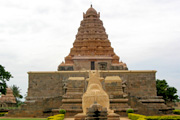 The name Gangaikondacholapuram means “the town of the Chola (ruler) who conquered Ganga”. Here, after a successful military campaign, the Chola ruler Rajendra I established a new capital in the 11th century and erected in its center an elegant, spacious temple complex with a 60 m high structure (Vimana) on top of the main sanctuary. After his death, the city passed into oblivion; the perimeter wall and the entrance tower of the temple were used as a quarry. Today, only the main sanctuary still stands, with its somewhat concavely curved Vimana, in the center of a well kept complex. Niche sculptures of unique elegance attest to the excellent understanding of art during the Chola era and present a broad spectrum of Hindu Gods. The complex has been a UNESCO World Heritage Site since 2004.
The name Gangaikondacholapuram means “the town of the Chola (ruler) who conquered Ganga”. Here, after a successful military campaign, the Chola ruler Rajendra I established a new capital in the 11th century and erected in its center an elegant, spacious temple complex with a 60 m high structure (Vimana) on top of the main sanctuary. After his death, the city passed into oblivion; the perimeter wall and the entrance tower of the temple were used as a quarry. Today, only the main sanctuary still stands, with its somewhat concavely curved Vimana, in the center of a well kept complex. Niche sculptures of unique elegance attest to the excellent understanding of art during the Chola era and present a broad spectrum of Hindu Gods. The complex has been a UNESCO World Heritage Site since 2004.
Gingee
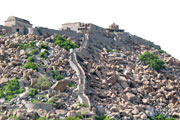 Near the small town of Gingee is a historic fortress that extends across three large hills in a picturesque rocky landscape. A 5 km long fortification wall encloses an area of 7 km² with historic buildings from different eras. The construction of the fortress began in the 13th century during the Chola dynasty. Later, the fort changed hands several times, coming under the control of rulers from the Vijayanagara, Nayak, Bijapur, Maratha and Mogul dynasties. Inside the fort are granaries, barracks, training halls, stables, temples and the remains of a former palace complex. Definitely worth seeing is the Kalyana Mahal with its octagonal tower, built around 1550 in Indo-Saracenic style. The climb to the citadel of the Rajagiri hill is particularly worthwhile because of the wonderful views.
Near the small town of Gingee is a historic fortress that extends across three large hills in a picturesque rocky landscape. A 5 km long fortification wall encloses an area of 7 km² with historic buildings from different eras. The construction of the fortress began in the 13th century during the Chola dynasty. Later, the fort changed hands several times, coming under the control of rulers from the Vijayanagara, Nayak, Bijapur, Maratha and Mogul dynasties. Inside the fort are granaries, barracks, training halls, stables, temples and the remains of a former palace complex. Definitely worth seeing is the Kalyana Mahal with its octagonal tower, built around 1550 in Indo-Saracenic style. The climb to the citadel of the Rajagiri hill is particularly worthwhile because of the wonderful views.
Kanchipuram
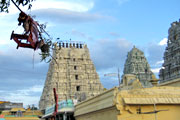 According to Indian tradition, the pilgrimage center of Kanchipuram, equally dedicated to the gods Shiva and Vishnu, is among the seven holy cities of Hinduism. The remarkable cultural-historical past of the place, which already existed in the pre-Christian era, began in the 4th century, when the Pallava dynasty elevated Kanchipuram to the status of capital. Its lovely temples from three South Indian cultural epochs (Pallava, Chola and Vijayanagara) make a visit to this town worthwhile. The oldest of the surviving temples is the Kailasanatha temple, a Shiva temple built towards the end of the 7th century and considered one of the finest examples of the early Dravidian temple style. The Vaikuntha Perumal temple, dating back to the 8th century and devoted to the god Vishnu, demonstrates the sophisticated architecture of the Pallava period. The largest temple is the Ekambareshvara temple, a Shiva shrine with five courtyards, built in 1509 by the Vijayanagara dynasty around a sacred mango tree. Kanchipuram also has a long tradition of producing fine silk fabrics.
According to Indian tradition, the pilgrimage center of Kanchipuram, equally dedicated to the gods Shiva and Vishnu, is among the seven holy cities of Hinduism. The remarkable cultural-historical past of the place, which already existed in the pre-Christian era, began in the 4th century, when the Pallava dynasty elevated Kanchipuram to the status of capital. Its lovely temples from three South Indian cultural epochs (Pallava, Chola and Vijayanagara) make a visit to this town worthwhile. The oldest of the surviving temples is the Kailasanatha temple, a Shiva temple built towards the end of the 7th century and considered one of the finest examples of the early Dravidian temple style. The Vaikuntha Perumal temple, dating back to the 8th century and devoted to the god Vishnu, demonstrates the sophisticated architecture of the Pallava period. The largest temple is the Ekambareshvara temple, a Shiva shrine with five courtyards, built in 1509 by the Vijayanagara dynasty around a sacred mango tree. Kanchipuram also has a long tradition of producing fine silk fabrics.
Kanyakumari
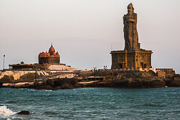 Located at Cape Comorin, Kanyakumari is the southernmost point of the Indian subcontinent. This is where three bodies of water meet: the Bay of Bengal, the Indian Ocean and the Arabian Sea. The sunrise over the ocean is spectacular, and at full moon it is a special experience to see the sun setting and the moon rising over the water at the same time. The main attraction for Hindu pilgrims is the temple of the virgin Goddess Kumari Amman, lending the town its name. The inner area of the sanctuary can however only be entered by Hindus. 300 m northwest of the temple is the Gandhi Mandapam, a modern imitation of an Orissa style temple. On one of two rocky islets just off the shore stands the Vivekananda Rock Memorial, featuring a statue of the famous reformer and saint, which can be visited by boat. In 2000, a 40 m high statue of the Tamil poet Thiruvalluvar was erected on the other rock.
Located at Cape Comorin, Kanyakumari is the southernmost point of the Indian subcontinent. This is where three bodies of water meet: the Bay of Bengal, the Indian Ocean and the Arabian Sea. The sunrise over the ocean is spectacular, and at full moon it is a special experience to see the sun setting and the moon rising over the water at the same time. The main attraction for Hindu pilgrims is the temple of the virgin Goddess Kumari Amman, lending the town its name. The inner area of the sanctuary can however only be entered by Hindus. 300 m northwest of the temple is the Gandhi Mandapam, a modern imitation of an Orissa style temple. On one of two rocky islets just off the shore stands the Vivekananda Rock Memorial, featuring a statue of the famous reformer and saint, which can be visited by boat. In 2000, a 40 m high statue of the Tamil poet Thiruvalluvar was erected on the other rock.
Karaikudi
The area around Karaikudi is home to the Nattukottai Chettiars, a prosperous merchant caste of historical importance. Even in pre-colonial times, the Chettiar community of successful bankers dominated the overseas trade with Burma, Ceylon, Java, Sumatra, Singapore and Vietnam, and they founded establishments throughout the whole of Asia in the 19th and 20th centuries. In and around Karaikudi are their palatial family residences, with their splendor an indication of the wealth of their architects. For their construction, precious materials were used, such as Burmese teak, Italian marble and Belgian glass. The stately residences are characterized by ornate entrance gates, impressive reception areas and column-lined inner courtyards, around which the rooms of the numerous family members are arranged. Many of the noteworthy buildings are uninhabited most of the year because their owners live in the city. They are open to visitors and provide inspiring insights into the fascinating culture and architecture of the Chettiars. A specialty is the spicy Chettinad cuisine, characterized by both the typical elements of Tamil cuisine and influences from Southeast Asia and Europe.
Kodaikanal
Lying at an altitude of over 2100 meters in the Palani hills, Kodaikanal is one of the “hill stations” of the South Indian mountains, areas that were developed into summer resorts by the British colonial rulers due to their cool climate. An artificial lake, which can be circumnavigated on foot, offers the opportunity of rides in row boats or pedal boats. On a hill side beside the lake is Bryant Park, known for its wonderful flower gardens and stylish park layout. The surrounding countryside offers nature lovers charming destinations for hikes and excursions. In clear weather, Coaker’s Walk grants visitors a breathtaking view of the plains below. Other popular destinations with magnificent views are the Kurinji Andavar Temple, the Green Valley View, the 122 meter high Pillar Rocks, the Bear Shola Falls and the Silver Cascade Falls.
Kumbakonam
Legend has it that the town of Kumbakonam, founded in the 9th century by the Chola dynasty, was formed around a lingam, the cult object of the Hindu god Shiva, who is said to have made it himself from a shattered pot of nectar (Kumbha). The place has several major temple complexes from the 12th and 13 century, either dedicated to the god Vishnu or Shiva. At the center of the city is the Mahamaham tank which, according to a myth, is fed every 12 years with holy Ganges water. The main temples among the many shrines are the Kumbareshwara Temple, the Sarangapati Temple and the Nageshwara Swami Temple.
Madurai
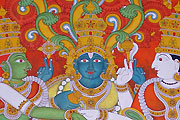 According to mythology, in Madurai Shiva took his consort Parvati to wife in the form of the beautiful Pandya princess Meenakshi. The Meenakshi temple, built in the 16th century during the Nayak period, represents the late stage of Dravidian temple architecture. Towards the north is the Sundareswarar temple, dedicated to Shiva in the form of Sundareswar, the beautiful lord. Both temples are part of an impressive overall complex which draws the visitor into a mystical world with the bright and colorful decoration of its temple towers, the half-dark colonnades, the traditional processions, the illuminated side shrines and the abundance of mythological motifs. Also worth seeing are the temple museum and the market with devotional items, housed in two large temple halls, where many pilgrims buy their souvenirs. Other attractions in Madurai are the Thirumalai Nayak Palace, built in the 17th century in Indo-Saracenic style, and the Gandhi Memorial Museum.
According to mythology, in Madurai Shiva took his consort Parvati to wife in the form of the beautiful Pandya princess Meenakshi. The Meenakshi temple, built in the 16th century during the Nayak period, represents the late stage of Dravidian temple architecture. Towards the north is the Sundareswarar temple, dedicated to Shiva in the form of Sundareswar, the beautiful lord. Both temples are part of an impressive overall complex which draws the visitor into a mystical world with the bright and colorful decoration of its temple towers, the half-dark colonnades, the traditional processions, the illuminated side shrines and the abundance of mythological motifs. Also worth seeing are the temple museum and the market with devotional items, housed in two large temple halls, where many pilgrims buy their souvenirs. Other attractions in Madurai are the Thirumalai Nayak Palace, built in the 17th century in Indo-Saracenic style, and the Gandhi Memorial Museum.
Mahabalipuram
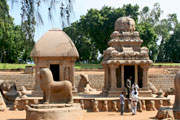 In Mahabalipuram (also called Mamallapuram) one can combine beach fun with a bit of cultural history. Situated directly on the Coromandel coast, the site is regarded as the cradle of South Indian culture and is a true archaeological treasure trove, with masterpieces from the Pallava period (6th – 8th century). In 1985, the monuments were declared a UNESCO World Heritage Site. Attractions include the Monolith temple and the Cave temple, with its magnificent imagery of the gods. It was the first temple in the region constructed from stone blocks. Large reliefs chiseled in granite narrate well known legends of Hindu mythology. The monolithic “Five Rathas” monuments served as architectural models on the basis of which the fundamental elements of Dravidian temple construction were developed. A huge boulder, located on a steep rocky ridge, is known as “Krishna’s Butterball” and presents a popular photo opportunity. Mahabalipuram is also a center of traditional sculpture. Indian statues of the gods in granite, marble and soapstone are still made by hand here in small family businesses.
In Mahabalipuram (also called Mamallapuram) one can combine beach fun with a bit of cultural history. Situated directly on the Coromandel coast, the site is regarded as the cradle of South Indian culture and is a true archaeological treasure trove, with masterpieces from the Pallava period (6th – 8th century). In 1985, the monuments were declared a UNESCO World Heritage Site. Attractions include the Monolith temple and the Cave temple, with its magnificent imagery of the gods. It was the first temple in the region constructed from stone blocks. Large reliefs chiseled in granite narrate well known legends of Hindu mythology. The monolithic “Five Rathas” monuments served as architectural models on the basis of which the fundamental elements of Dravidian temple construction were developed. A huge boulder, located on a steep rocky ridge, is known as “Krishna’s Butterball” and presents a popular photo opportunity. Mahabalipuram is also a center of traditional sculpture. Indian statues of the gods in granite, marble and soapstone are still made by hand here in small family businesses.
Mudumalai Wildlife Sanctuary
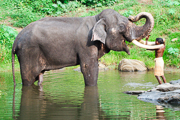 The Mudumalai Wildlife Sanctuary is located in the northern foothills of the Nilgiri mountains and covers a total area of 320 km². It is bordered on the western and northern side by the wildlife sanctuaries of Bandipur (Karnataka) and Wayanad (Kerala), and covered largely by tropical dry forest with many hardwood trees. The fauna is rich in wildlife species: sambar deer, spotted gazelles, blackbucks, antelopes, wild buffalo, elephants, monkeys, wild boar, giant squirrel and occasionally even leopards and tigers. The Moyar River is also a habitat for otters and crocodiles. The lord of the jungle is undoubtedly the wild elephant, which appears in large herds. Work animals for forest management and timber production are kept in an elephant camp. On a multi-hour jeep safari, one can – with some luck – observe wild animals in their free, natural habitat. There is also the possibility of going for hikes with an experienced guide in the vicinity of the wildlife park.
The Mudumalai Wildlife Sanctuary is located in the northern foothills of the Nilgiri mountains and covers a total area of 320 km². It is bordered on the western and northern side by the wildlife sanctuaries of Bandipur (Karnataka) and Wayanad (Kerala), and covered largely by tropical dry forest with many hardwood trees. The fauna is rich in wildlife species: sambar deer, spotted gazelles, blackbucks, antelopes, wild buffalo, elephants, monkeys, wild boar, giant squirrel and occasionally even leopards and tigers. The Moyar River is also a habitat for otters and crocodiles. The lord of the jungle is undoubtedly the wild elephant, which appears in large herds. Work animals for forest management and timber production are kept in an elephant camp. On a multi-hour jeep safari, one can – with some luck – observe wild animals in their free, natural habitat. There is also the possibility of going for hikes with an experienced guide in the vicinity of the wildlife park.
Ootacamund (Ooty – Udhagamandalam)
The “Hill Station” of Ootacamund (also known as Ooty, or Udhagamandalam) is located in the Nilgiri mountains at an altitude of 2300 m altitude. The place was developed in the 19th century by the British colonialists into the most popular summer resort in South India. Although the reckless development in recent years has erased many of the remnants of the British colonial era, today’s travelers still feel attracted to Ooty’s cool climate, the green of the surrounding hills and the fresh mountain air. A special attraction is the Botanical Garden, which was created in 1847 by the gardeners of London’s Kew Gardens. It stretches out over 20 hectares with immaculate lawns, manicured trees and landscaped ponds and flower beds with more than a thousand different types of flowers and shrubs. Dodabeta, in the vicinity of Ooty, is the highest peak in the Nilgiris at 2638 meters, and a very popular destination for a day trip. Another attraction is the ride on the Nilgiri Blue Mountain Railway, a narrow gauge railway, which leads up all the way from Mettupalayam on the plains via Hillgrove and Conoor to Ooty. The original inhabitants of the mountain region in and around Ooty are the Toda, a hill tribe with its own culture and language.
Palani
In Hinduism, Murugan (also called Subramanyan or Kartikeyan) is a son of Lord Shiva and his consort Parvati, worshipped with great devotion in South India. Situated on a hilltop, the Dhandayudhapani temple in Palani is the most famous Murugan shrine in Tamil Nadu. With over 7 million pilgrims every year, the temple – its sanctum crowned by a gilded dome – is the most visited place of worship in the region. The ascent is made via an imposing flight of stairs. Pilgrims often dance their way up the many steps to the sanctuary. From halfway up, there is also a stairless path that used to be trodden by elephants. The highlight is the nightly procession in which the deity is carried around the temple with great pomp. There is a joyful mood in the air, which is also found in the town of Palani.
Puducherry (Pondicherry)
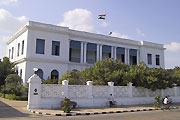 Puducherry (Pondicherry) is a town with a pleasant atmosphere and peaceful charm. It is situated in the union territory of the same name, and had been in French hands for almost three centuries. Pondicherry – renamed Puducherry in 2006 – as with other French enclaves, was only returned to the Indian government in 1954. Its French characteristics and its location on the Bay of Bengal make the city a popular tourist destination. The French way of life has left its mark, especially in the former colonial district near the waterfront. Architecturally, the combination of French influences and traditional Indian design is interesting. An evening stroll along the beach promenade offers an opportunity to visit the Gandhi Memorial, a city landmark. Pondicherry is also home to the ashram of Sri Aurobindo. Born in Calcutta in 1872, this freedom fighter, yogi and philosopher is one of the great spiritual masters of the 20th century. He developed a method of spiritual practice known as “Integral Yoga”.
Puducherry (Pondicherry) is a town with a pleasant atmosphere and peaceful charm. It is situated in the union territory of the same name, and had been in French hands for almost three centuries. Pondicherry – renamed Puducherry in 2006 – as with other French enclaves, was only returned to the Indian government in 1954. Its French characteristics and its location on the Bay of Bengal make the city a popular tourist destination. The French way of life has left its mark, especially in the former colonial district near the waterfront. Architecturally, the combination of French influences and traditional Indian design is interesting. An evening stroll along the beach promenade offers an opportunity to visit the Gandhi Memorial, a city landmark. Pondicherry is also home to the ashram of Sri Aurobindo. Born in Calcutta in 1872, this freedom fighter, yogi and philosopher is one of the great spiritual masters of the 20th century. He developed a method of spiritual practice known as “Integral Yoga”.
Srirangam
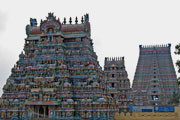 Located on an island in the Cauvery river, the temple town of Srirangam, with its Sri Ranganathaswamy Temple, is a prominent center of the South Indian Vishnu cult. With its seven concentric courtyards and 21 entrance gates, the impressive temple complex is the largest in India. The outer three courtyards form an urban quarter, with dwellings for the Brahmins and with shops, offering a wide variety of devotional items and memorabilia for the pilgrims. The actual temple area is situated at the grounds of the four innermost surrounding walls and is dedicated to the God Ranganatha, a representation of the world preserver Vishnu. Many saints, poets and philosophers have lived in Srirangam. In the 12th century, for example, the famous philosopher Ramanuja, the founder of the Vishishtadvaita doctrine, worked here. Several South Indian dynasties have contributed to the construction of the complex. Particular highlights are the panoramic terrace and the horse riding hall built by the Vijayanagara dynasty.
Located on an island in the Cauvery river, the temple town of Srirangam, with its Sri Ranganathaswamy Temple, is a prominent center of the South Indian Vishnu cult. With its seven concentric courtyards and 21 entrance gates, the impressive temple complex is the largest in India. The outer three courtyards form an urban quarter, with dwellings for the Brahmins and with shops, offering a wide variety of devotional items and memorabilia for the pilgrims. The actual temple area is situated at the grounds of the four innermost surrounding walls and is dedicated to the God Ranganatha, a representation of the world preserver Vishnu. Many saints, poets and philosophers have lived in Srirangam. In the 12th century, for example, the famous philosopher Ramanuja, the founder of the Vishishtadvaita doctrine, worked here. Several South Indian dynasties have contributed to the construction of the complex. Particular highlights are the panoramic terrace and the horse riding hall built by the Vijayanagara dynasty.
Suchindran
The construction of the Stanunathaswami Temple in Suchindran, 12 km northwest of Kanyakumari, extended over a period of more than 600 years. The oldest parts date from the 9th and 10th centuries, the latest parts from the 15th century. The impressive, pyramidal gopuram (entrance tower) of the temple was built in the 16th century. The main sanctuary is dedicated to the Hindu Gods Brahma, Vishnu and Shiva. Other attractions of the complex are its “musical” pillars, which emit a chime when struck, and a 3 meter high statue of Hanuman. Every Friday at sunset, a special prayer ceremony (puja) takes place with music and a procession.
Swamimalai
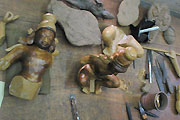 The small town of Swamimalai is a traditional center of South Indian bronze casting. Statues of the gods are still made by hand here in bronze and other metals, in small craft associations and family businesses. The traditional moulds were developed nearly 1,000 years ago during the Chola period and are still considered perfect images of the represented deities. The challenge for the artist is to make a perfect reproduction of the material form and the divine characteristics it expresses. The masters of this traditional craft happily invite visitors into the workshops to get an impression of their ancient craft, which requires the preparation of a wax mould prior to the production of each sculpture.
The small town of Swamimalai is a traditional center of South Indian bronze casting. Statues of the gods are still made by hand here in bronze and other metals, in small craft associations and family businesses. The traditional moulds were developed nearly 1,000 years ago during the Chola period and are still considered perfect images of the represented deities. The challenge for the artist is to make a perfect reproduction of the material form and the divine characteristics it expresses. The masters of this traditional craft happily invite visitors into the workshops to get an impression of their ancient craft, which requires the preparation of a wax mould prior to the production of each sculpture.
Thanjavur
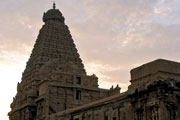 The Brihadeeswarar temple in Thanjavur, built at the beginning of the 11th century by the Chola ruler Rajaraja I in a record time of 6 years, is regarded as a sublime masterpiece of Dravidian temple architecture. The complex, which has been a UNESCO World Heritage Site since 1987, is characterized by its simple and balanced design. After passing two entrance towers guarded by stern-looking dwarapalakas (door guards), the visitor enters a spacious courtyard with the majestic sanctuary at its center. The 16-storey structure above the main chamber is crowned by an 80-ton monolithic dome. In the courtyard, in front of the main sanctuary, is the Nandi Mandapam, a detached colonnade with a large statue of Nandi (Shiva’s bull). There are secondary shrines for the worship of Shiva’s consort Parvati and their sons Ganesha and Subramanyan (Kartikeya). At sunset, the temple complex, built of sandstone, emits a reddish glow. Another attraction is the art gallery in the Nayak Palace, where one can see an impressive collection of ancient bronzes and stone sculptures from the Chola period.
The Brihadeeswarar temple in Thanjavur, built at the beginning of the 11th century by the Chola ruler Rajaraja I in a record time of 6 years, is regarded as a sublime masterpiece of Dravidian temple architecture. The complex, which has been a UNESCO World Heritage Site since 1987, is characterized by its simple and balanced design. After passing two entrance towers guarded by stern-looking dwarapalakas (door guards), the visitor enters a spacious courtyard with the majestic sanctuary at its center. The 16-storey structure above the main chamber is crowned by an 80-ton monolithic dome. In the courtyard, in front of the main sanctuary, is the Nandi Mandapam, a detached colonnade with a large statue of Nandi (Shiva’s bull). There are secondary shrines for the worship of Shiva’s consort Parvati and their sons Ganesha and Subramanyan (Kartikeya). At sunset, the temple complex, built of sandstone, emits a reddish glow. Another attraction is the art gallery in the Nayak Palace, where one can see an impressive collection of ancient bronzes and stone sculptures from the Chola period.
Tirukalikundram
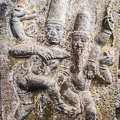 The 7th century hill temple dedicated to Shiva is accessible via some 500 granite steps. The priests at this temple often feed birds of prey at noon. According to Hindu mythology, the birds – on their way from Varanasi to Rameshvaram – settle on a rock in front of the temple to eat there. It is a custom that has been documented for more than 500 years, but there’s no guarantee of a feeding every day. To escape the midday heat during the steep ascent, we recommend a visit later in the afternoon. With its beautiful view, the temple terrace makes for an ideal place to enjoy the atmospheric South Indian sunset.
The 7th century hill temple dedicated to Shiva is accessible via some 500 granite steps. The priests at this temple often feed birds of prey at noon. According to Hindu mythology, the birds – on their way from Varanasi to Rameshvaram – settle on a rock in front of the temple to eat there. It is a custom that has been documented for more than 500 years, but there’s no guarantee of a feeding every day. To escape the midday heat during the steep ascent, we recommend a visit later in the afternoon. With its beautiful view, the temple terrace makes for an ideal place to enjoy the atmospheric South Indian sunset.
Tiruchirapalli (Trichy)
The main landmark and tourist attraction of the city of Tiruchirapalli, or Trichy in short form, is the Rockfort. Perched on a 83 m high rock, this hill fort was a coveted military stronghold of the early South Indian dynasties. There are about 450 steps leading to the top of the fortress hill, where two Hindu temples are located; non-Hindus, however, are not allowed access. The climb is worth it because of the great view of the Cauvery river and the surrounding countryside, especially at sunset.
Tiruvannamalai
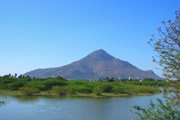 The pilgrimage town of Tiruvannamalai is situated at the foot of the holy Arunachala mountain, which is regarded as a manifestation of Lord Shiva. Sri Ramana Maharshi, one of the most widely recognized masters of Advaita Vedanta in the 20th century, lived on the Arunachala. A visit to the Sri Ramana Ashram is highly recommended. A footpath leads from there to the holy mountain, where two chapels can be found that accommodated the master for many years and which visitors can access during the day for meditation. From the mountain, you have a wonderful view of the city’s Arunachaleshvara temple, where Shiva is worshiped in the form of the Fire element. The temple complex, divided into three courtyards, is among the most famous sanctuaries in Tamil Nadu. The oldest parts of the temple, which was completed in its present form in the 17th century, are typical of the Chola architecture and date back to the 11th century. The white color of the temple towers symbolizes purity. During full moon nights, Tiruvannamalai is a popular place of pilgrimage for several hundred thousand Hindus who, as per traditional practice, walk around the sacred mountain. Tradition has it that Shiva appeared at the mountain, first in the form of a pillar of light. On the full moon of the Tamil month Karthikai (November/December), a large fire is lit on top of the mountain, in reminiscence of the appearance of the light column.
The pilgrimage town of Tiruvannamalai is situated at the foot of the holy Arunachala mountain, which is regarded as a manifestation of Lord Shiva. Sri Ramana Maharshi, one of the most widely recognized masters of Advaita Vedanta in the 20th century, lived on the Arunachala. A visit to the Sri Ramana Ashram is highly recommended. A footpath leads from there to the holy mountain, where two chapels can be found that accommodated the master for many years and which visitors can access during the day for meditation. From the mountain, you have a wonderful view of the city’s Arunachaleshvara temple, where Shiva is worshiped in the form of the Fire element. The temple complex, divided into three courtyards, is among the most famous sanctuaries in Tamil Nadu. The oldest parts of the temple, which was completed in its present form in the 17th century, are typical of the Chola architecture and date back to the 11th century. The white color of the temple towers symbolizes purity. During full moon nights, Tiruvannamalai is a popular place of pilgrimage for several hundred thousand Hindus who, as per traditional practice, walk around the sacred mountain. Tradition has it that Shiva appeared at the mountain, first in the form of a pillar of light. On the full moon of the Tamil month Karthikai (November/December), a large fire is lit on top of the mountain, in reminiscence of the appearance of the light column.
